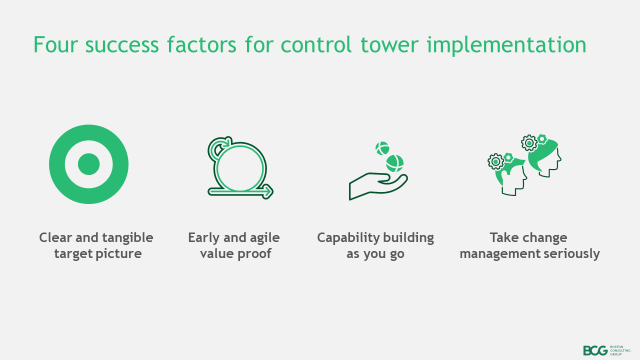BCG — Boston Consulting Group
Dr. Stefan Gstettner; Gideon Walter, and Pepe Rodriguez
April 9, 2019
My colleague Pepe Rodriguez and I (Stefan Gstettner) scanned many successful control tower projects and distilled a recipe for success
- Important to mix a clear vision with agile value delivery
- Sprinkle the required people capabilities
- Add a healthy dose of change management
In our last post, Gideon Walter and I talked about the reasons why supply chain control tower implementations fail.
Of course, we do not want to leave you with only a statement of the problems.
Therefore, my colleague Pepe Rodriguez and I looked at successful control tower implementations and distilled the main reasons why they became a success.
We summarize our findings in the simple picture below.

We find that successful control tower implementations are highly action-oriented. However, the successful companies have followed the saying, “no action without direction.”
A clear, ambitious, and tangible target picture is therefore the prerequisite for future success. Additionally, the process of getting to this target picture is important.
Successful companies follow a mix of “immersion sessions,” diagnostics, and early MVP creation.
The reason for that is that many of the benefits of digital SCM cannot be experienced with concepts; the management teams therefore took efforts to make the future vision as tangible as possible.
A clear, ambitious, and tangible target picture is the prerequisite for future success.
For example, at a global biopharma client an early prototype for supply chain visibility was focused on enabling tiered meeting cascade at the manufacturing plants.
The MVP was developed iteratively with plant and workcenter leaders, ensuring that the insights provided by the analytics were action-oriented, integrated with the business process, and value-driving.
The MVP was then used as a proven “user specification” for an industrialized visibility solution.
Once the direction is clear, early successes are the best change accelerator.
We have seen that successful companies focus their initial efforts on two aspects — first, they prove that new approaches can generate value very quickly and, second they set critical foundations for the future.
We often see complex planning tasks as use cases for quick value generation.
A popular example here is AI-based demand planning.
However, industry-specific challenges can also be the starting point.
For example, we learned that an automotive OEM started their digital journey by optimizing the routing of finished vehicle outbound transportation.
Their value-oriented objectives were to: reduce cost, avoid double-handling in vehicle distribution centers, and minimize the risk of damages.
A great example of key foundational elements pursued early are data platforms.
Defining the target architecture and the data management and governance processes of a data lake is often chosen as one of the first initiatives.
It serves as a basis to implement the predefined sequence of use cases according to the target picture.
Several roll-out waves generate value and sequentially result in the full digital transformation.
Another core ingredient of successful digital supply chain transformations — and thus also of control tower implementations — are people with the right capabilities.
Successful companies effectively segment the types of capabilities that are required and hire or upskill the selected future SC staff early.
We see three levels of capabilities needed:
- Running the new processes and solutions and understanding all the links in the end-to-end supply chain
- Optimizing the analytical procedures that are part of the core use cases; for example, constantly tuning the demand forecasting engine by adapting the critical parameters and reacting to changes in the market
- Creating new digital and analytics solutions; for this, fully educated data scientists with a specialized education are often required, whereas the first two levels of qualifications can be acquired on the job
It is clear from all of our conversations with supply chain executives that all of the above topics require a massive amount of change.
However, as we have laid out in the previous post, many companies still underestimate this challenge.
Let’s discuss one of the many elements of change management to illustrate this better.
We find that successful companies truly identify the intrinsic motivators of their employees. Few people are unable to change (maybe due to capability limitations) — more people may simply be unwilling to change because they don’t see a personal advantage.
It is critical to find the true motivators for change, then make a substantial effort to account for these by laying out future opportunities and changing incentive schemes.
While we believe these are the ingredients for success, we are aware that there isn’t a single recipe that all companies can follow.
However, we hope that our two posts inspire an educated discussion of how we all can make control tower implementations successful.
We strongly believe that this is a core element of the important digital transformation in supply chain management.
Originally published at:










